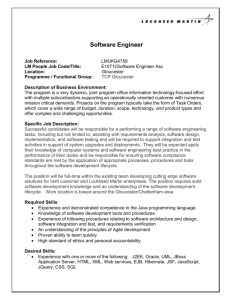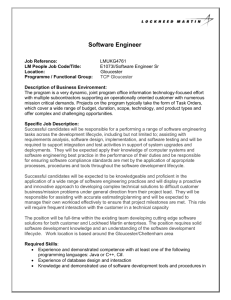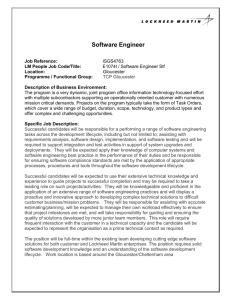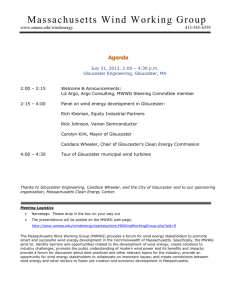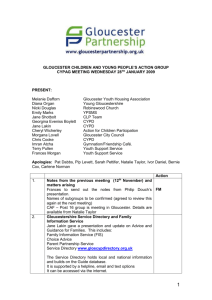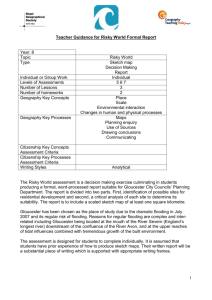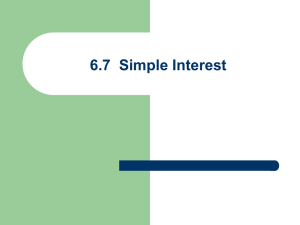PRT report
advertisement
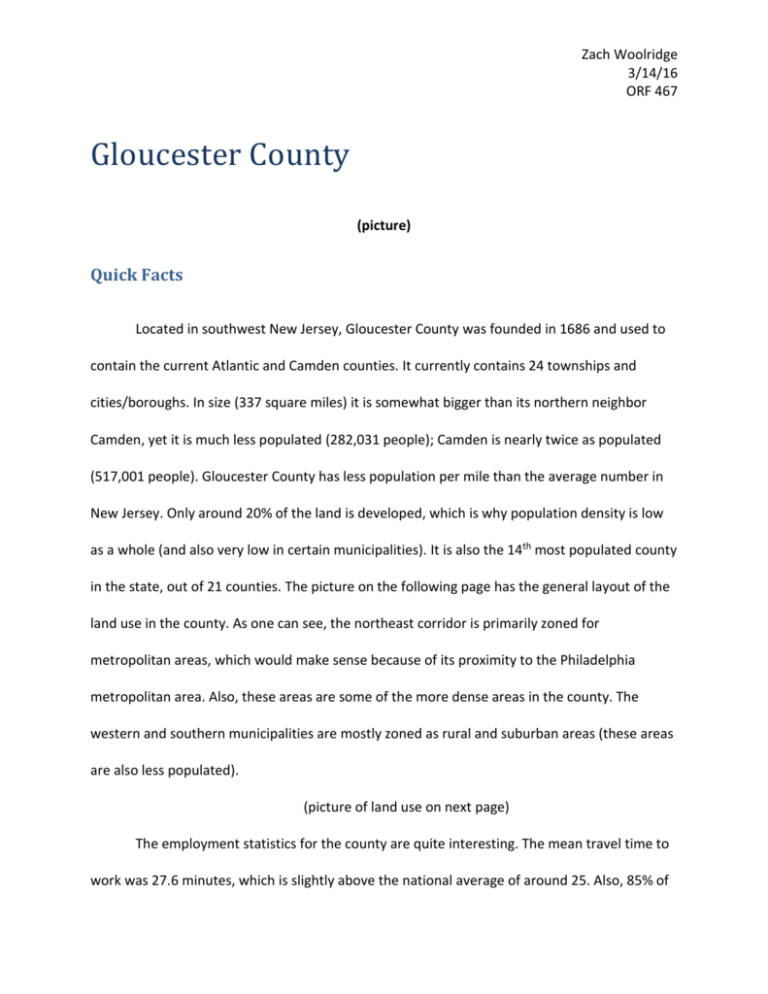
Zach Woolridge 3/14/16 ORF 467 Gloucester County (picture) Quick Facts Located in southwest New Jersey, Gloucester County was founded in 1686 and used to contain the current Atlantic and Camden counties. It currently contains 24 townships and cities/boroughs. In size (337 square miles) it is somewhat bigger than its northern neighbor Camden, yet it is much less populated (282,031 people); Camden is nearly twice as populated (517,001 people). Gloucester County has less population per mile than the average number in New Jersey. Only around 20% of the land is developed, which is why population density is low as a whole (and also very low in certain municipalities). It is also the 14th most populated county in the state, out of 21 counties. The picture on the following page has the general layout of the land use in the county. As one can see, the northeast corridor is primarily zoned for metropolitan areas, which would make sense because of its proximity to the Philadelphia metropolitan area. Also, these areas are some of the more dense areas in the county. The western and southern municipalities are mostly zoned as rural and suburban areas (these areas are also less populated). (picture of land use on next page) The employment statistics for the county are quite interesting. The mean travel time to work was 27.6 minutes, which is slightly above the national average of around 25. Also, 85% of Zach Woolridge 3/14/16 ORF 467 people drive alone to work, with only 7.5% carpooling. Overall, around 93% of people are travelling to work using private transportation of some sort, a fairly high number. A significant amount of people work outside the state of New Jersey, with about 18% of people working outside of the state. To go along with those 18% of people that work outside of the state, about 36% work outside of the county. The following picture shows the breakdown of townships and cities: (picture) Gloucester County has access to the I-95, I-295, and I-76, so other parts of the state and other states as well (Pennsylvania) are easily accessible by highway. But for the other 46% of residents that work in the county, we can try to create a PRT network that optimizes their travel time. As we can see by the following map, a few of the county subdivisions have mean travel times that are over 30 minutes (the county average is 27.6). Specifically, Franklin Township, Monroe Township, Washington Township, Logan Township, Woolwich Township, and South Harrison Township all had mean travel times over 30 minutes, which is at least 5 minutes above the national average. A possible cause for the long travel times in the southeastern part of the county is workers commuting to Philadelphia to work. If that reason is the prevailing reason for long travel times, there may not be as much improvement using a PRT model. In the meantime, we can try to figure out ways to alleviate long travel times within the county. (picture) Zach Woolridge 3/14/16 ORF 467 In general, population density for most of Gloucester County is quite low, with an average of 876 people per square mile. And with the exception of a few cities which bump up that average, namely Pitman borough, Westville borough, and Woodbury city, around 50% of the county land has a population density below 700 people per square mile. Interestingly enough, the areas that have the least population density have the longer travel times. All of the townships which lie along the south border of the county have low population densities, due to the amount of farmland in each township. Unfortunately, because of the undeveloped land that separates many residents from their jobs (unless they work on their own farm), those residents will still have fairly long trips to their respective jobs. That is one of the possible explanations for the higher mean travel time for the townships with the least population density. Only 2.5% of people use public transportation to get to work, which is a very low number in comparison to most places. The bus systems are not connected well throughout the county, with one publication saying that the east to west bus service was strong, but going the opposite direction it was nearly nonexistent. One of the databases said the following about the current NJ Transit bus route situation in Gloucester: NJ Transit operates 11 regular bus routes in Gloucester County. The 11 routes consist of: Nine regional interstate routes providing service through Gloucester and Camden Counties to Philadelphia: 313, 315, 400, 401, 402, 403, 408, 410, 412; two intrastate routes: one regional (455) and one local (463). All routes except the 412 and 463 operate seven days a week. The 313 and 315 are shore routes (Cape May to Philadelphia) with limited schedules. Other routes, such as the 401, 402, and the 410, operate limited service during the midday. This limited service may prove a hardship to riders relying on buses to get to employment centers, especially if the jobs require shift work during off peak hours. PRT Design Zach Woolridge 3/14/16 ORF 467 (big picture of design) For the design, I tried to give the cities and most populated municipalities the most stations. The layout of the network follows fairly closer to the population densities of each sub county. Large areas that were undeveloped did not have stations but just arcs that ran through them. My general method for placing stations was making loops around small areas and connecting them via interchange. Below you can see how this general design idea was implemented for a section in Woodbury. (small picture of design) PRT Service to Education Gloucester County has one university (Rowan University) and one community college (Gloucester County College). Rowan University, a 4-year co-educational public university, has a suburban 200-acre campus located in Glassboro. Gloucester County College is a 2-year coeducational public community college that is located in West Deptford. In the PRT network, both of these universities have stations right on their campuses to service students and employees. Rowan University has 8,120 undergraduates and 1,218 graduate students, with around 3000 students living on campus, so quite a few people have to commute. The PRT system makes sure that these commuters are able to get to campus. In Gloucester County, there are around 140 private, public, parochial schools of every level. With around 78,000 school-aged children from nursery school to graduate school, our Zach Woolridge 3/14/16 ORF 467 system has stations within walking distance of most of the houses and most of the campuses. If a station is not right next to the school, there is a station within a half mile of the campus. PRT Service to Shopping Gloucester County has a few major shopping centers, namely the Deptford Mall. There is ample service (about 3 stations) to each part of that mall to make sure that people do not have to make excessively long walks to reach some of the department stores. All of the other strip malls that populate some of the city centers have stations either on site or within a mile or so. PRT Service to Housing The household population is 276,644 with around 100,000 total households. This comes up to an average household size of 2.76. In the townships with the more dense neighborhoods (Pitman, Westville, and Woodbury), there are quite a few more housing stations to accommodate them. But since Gloucester County is such a rural county on a whole, some of the remote areas are not serviced as well because of the amount of undeveloped land around them. Also, I did not place stations in certain residential areas because those specific areas contained a lot of undeveloped land or farmland, containing areas having very low population density. Most of the residents in these areas are within a mile or so of a station, so at the very least they can drive to the PRT station and possibly park in the general area. Because of the amount of housing stations, some of those stations serviced other types of places as well, such as businesses, schools, recreation, etc… Zach Woolridge 3/14/16 ORF 467 PRT Service to Recreation A table that summarizes the recreational opportunities in Gloucester County is as follows: Arts Organizations (in Gloucester County) 2 Rowan University Center for the Arts, Cultural & Heritage Commission AC Casino Oceanfront Resorts several Trump Taj Mahal, Bally's, Tropicana, Sands, AC Hilton, etc. Beaches (riverfront only) 1 Red Bank Battlefield (no public swimming permitted) Lakes 5 County Park System (public swimming permitted) Boating (riverfront) 2 Private Marinas (lake boating at county parks) City/State Parks 9 County Department of Parks and Recreation Golf Courses (9, 18 & 27 Hole) 10 Pitman Golf Course (county owned and operated) Movie Theaters 5 United Artist, Regal Cinemas, AMC, GCC, Pitman Theater Museums 5 County Park System Public Swimming Pools 3 Rowan University, Gloucester County Institute of Technology, YMCA Symphony (in Camden County) 1 Haddonfield Symphony Tennis Courts 17 Available at Public Schools and various County/City Parks The PRT network has stations are nearly all of these facilities, or at least a station within a mile of each one. A few of the state parks in the middle of undeveloped land may not be directly serviced, but they are not too far from any station. PRT Service to Employment Some of the major private sector employers in the area are Underwood-Memorial Hospital (1776 employees), Rowan University (1637 employees), Kennedy Memorial Hospital Zach Woolridge 3/14/16 ORF 467 (1035 employees), and Sony Music (located in Pitman with 582 employees). There are about 140,000 currently employed citizens who reside in the county, with around 64,000 of them working in the county. Most of these people have either “sales and office occupations” or management/professional and related occupations (combine to have 93,000 employees). The two industries with the most employees in Gloucester are retail trade (19,116 employees) and educational, health, and social services (27,605 employees). Also, Gloucester County is home to the Pureland Industrial Complex, a 3000 acre industrial park with many different offices and warehouses for companies such as Mitsubishi, Home Depot, Nextel, etc. It happens to be one of the largest industrial parks in the world, and is already well connected with the major thoroughfares in the area (I-295, US highway 322, and US Highway 130). Our PRT network has quite a few stations in the industrial park, even though the complex is well connected via car and public transportation with buses and shuttles. There are 3 oil refineries in Gloucester County as well; the Eagle Point Refinery, the Paulsboro Asphalt Refinery, and the Paulsboro Refinery, which all are used by Sunoco, Citgo, and Valero, respectively. Each of these 3 refineries has quite a few stations running through them, making them easily accessible. Otherwise, most of the other major employers are accounted for at retail shops and even big megastores like Wal-Mart or ShopRite. Since there are quite a few stops in each townships business/town center, all of the businesses in the middle of the towns are accounted for. Zach Woolridge 3/14/16 ORF 467 Trip Estimations Most of the trip estimations were based on using population density numbers, enrollment numbers, and employment numbers for specific businesses. The municipalities along the southern border don’t have many stations since the small communities cannot support a station, due to the fact that there would be a low amount of trips. Otherwise, most of the dense cities had stations within about a mile of each other, with schools, golf courses, and some shopping centers having stops of their own. Value of PRT to Future Evolution of the County Because of the gaps between the undeveloped land and the developed land, a PRT system will help to keep the county properly connected. Instead of having to drive out of the way to get around farms, the PRT system can be a more direct path to the destination. Since the bus system is only functional for certain parts of the county and only works during certain periods, a PRT system can give service to areas that were slighted by the bus/shuttle services and it can work at any time convenient for the user.
